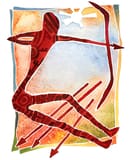We use the term "planets" and take it for granted, but defining it is more complicated than that. In general, anything solid that's shown in the chart is usually called a planet. Even the Sun and Moon are often called planets for convenience.
By comparison, there are also "points" which typically refer to calculated or non-physical places in the chart. For example, the Lunar Nodes, the Part of Fortune, Ascendant, Midheaven, and others.
Different Types of Planets or Celestial Bodies
Planets used most often in modern, Western astrology: Sun, Moon, Mercury, Venus, Mars, Jupiter, Saturn, Uranus, Neptune, Pluto.
The Lights: Sun and Moon.
Personal Planets: Mercury, Venus, Mars.
Societal or Social Planets: Jupiter and Saturn.
Traditional Planets: Sun, Moon, Mercury, Venus, Mars, Jupiter, Saturn.
Modern Planets or Transpersonal Planets: Uranus, Neptune, Pluto.
Asteroids: Ceres, Juno, Pallas Athena, Vesta are the major asteroids and most often used, and sometimes Hygeia and Astraea. Other work may include upwards of 10,000 minor asteroids.
Centaurs: Chiron
New Planets: Eris, Sedna, Makemake, Quaoar and others.
The Problem of Pluto
In science and astronomy, a planet is one of 8 specific celestial bodies in our solar system: Mercury, Venus, Earth, Mars, Jupiter, Saturn, Uranus and Neptune. Pluto was classified as a planet when it was discovered in 1930, but in 2006 it was reclassified as a Dwarf Planet. However, Pluto is still used as a primary planet in astrology charts. Why? Because scientific classifications are intended to meet astronomy's work, and while astrology uses scientific information (planetary cycles, positions, etc) we use that information in a dramatically different way. The scientific reclassification of Pluto doesn't affect how Pluto functions in an astrology chart.














